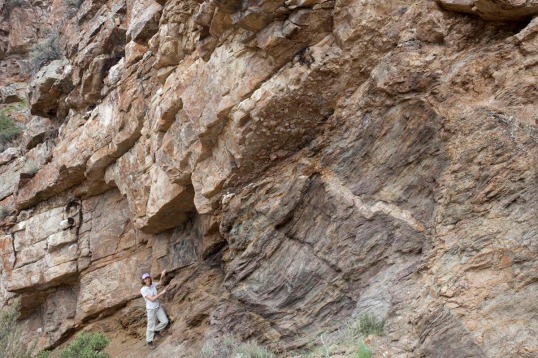San Andreas Fault
Here’s a view of the San Andreas fault and Pt. Reyes in northern California, looking northward. The fault runs right up the narrow Tomales Bay–and in just a few miles, runs along the edge of San Francisco.
The San Andreas fault is amazingly well-studied –it’s probably the most-studied fault zone in the world. After all, it is capable of generating huge earthquakes in heavily populated areas, so the more we know about it the better.

Aerial view of San Andreas fault and Pt. Reyes --just north of San Francisco. View is to the north. The fault runs down Tomales Bay, the narrow arm of the ocean that runs diagonally across the photo.
One thing we know about the San Andreas is that it generally moves in a side-by-side way (strike-slip) so that rock on the east side moves south relative to that on the west side. And over time, the fault has moved the eastern rock more than 300km relative to the western rock.
Now, 300 km –that speaks to millions of years of geologic time. We can measure the rate at which the Pacific Plate moves relative to the North American Plate –about 4.5 cm/year. The San Andreas takes up most of that –but not all. But if we assume it takes it all, we’re looking at a total of 300km at 4.5cm/year –so at least 6.6 million years.
Of course… if you think planet Earth is only 10,000 years old, that means the fault’s moved some 300 meters (3 football fields) every 10 years. And considering that the displacement was about 6 meters during the M 8.3 1906 San Francisco Earthquake…that’s a lot of earthquakes in just a short period of time!
Or another way of putting it, if planet Earth were 10,000 years old AND the San Andreas fault formed at the very beginning, 10,000 years ago… then there must have been 50 of those San-Francisco-sized Earthquakes every ten years –or… 5 of those every year. Yikes!
But of course… we know that the San Andreas isn’t as old as the planet. It cuts that granite at Pt. Reyes… which is related to the Sierra Nevada granite –which is really pretty young –but older than 10,000 years by about 100 million.
click here if you want to see more photos of the San Andreas fault –with a map!



